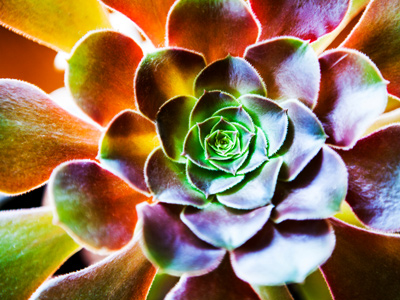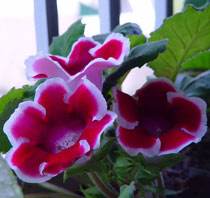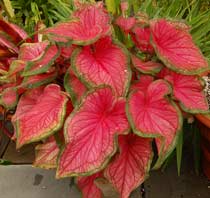
Houseplants come in a wide variety.
Houseplants - Houseplants 2
It is an unfortunate fact of houseplant growing that the more ordinary a plant looks, the longer it will last in the home.
A gloxinia will look spectacular for a short while but a swiss cheese plant will be only a baby when the gloxinia dies. A caladium will keel over and die if you look at it the wrong way but an ivy will still be happily waiting for you if you leave it in a freezing house while you go on holiday for a fortnight. You pays your money....
1 .
When growing a gloxinia from a tuber how deep should the tuber be planted?
Sitting on the surface
Lightly covered
An inch below the surface
Two inches below the surface
- Extremely showy plants that can either be purchased in bloom or (if you are more adventurous) grown from tubers.
- Like its close relative the saintpaulia it does not like water on its foliage.
- Gloxinia connoisseurs usually insist that the plant is stood in tepid water for up to an hour so that the compost sucks it up from the bottom.
- Strong sunlight will scorch the developing leaves whilst too little light will make them stretch and go leggy.
2 .
This leaf pattern is typical of which houseplant?
Money plant
Rubber plant
Swiss cheese plant
Zebra plant
- Latin Name: Monstera deliciosa.
- In Mexico an infusion is made from the roots which is believed to relieve the symptoms of arthritis!
- It grows quickly when provided with adequate warmth (over 20 degrees C), shade and high humidity - all but the last are easily provided in the home.
- Frequent misting of the plant helps.
- As it grows it will need firm supports - poles wrapped in moss are often used.
3 .
Which type of ivy is this?
Canariensis
Colchica
Helix
Hibernica
- The non-variegated form is unexciting and seldom grown but the variegated forms (such as the one shown) can make excellent houseplants.
- In deep shade it will lose the colouring of the leaves and revert back to plain old green!
- It will tolerate a wide range of temperatures and even light frosts do not harm it.
- When growing strongly it requires a weekly dose of fertilizer and it will also need some form of support.
4 .
This is a Ficus benjamina. To which group of plants do Ficus belong?
Eucalyptus
Figs
Palms
Spruce
- Native to Asia and Australia.
- Easy to grow in homes and offices.
- There are a number of variegated forms but these are more difficult to look after than the plain green form.
- It is noted as a plant that adds a degree of elegance and sophistication wherever it is seen.
- Once settled it dislikes being moved and will quickly show its annoyance by dropping several leaves!
5 .
The edible asparagus is asparagus officinalis. The closely related plant that is grown as a houseplant is called what?
Asparagus deliciosus
Asparagus decorosus
Asparagus fernosus
Asparagus plumosus
- Sometimes referred to as the lace fern although it is not a fern at all.
- A native of South Africa.
- Foliage is sometimes used in floral decorations but it is best not to denude your prize houseplant for this purpose!
- Considering its very delicate appearance it is surprisingly drought-resistant.
- Compost should be allowed to become quite dry before watering.
6 .
This plant is variously known as heart of Jesus, angel wings and elephant ears but what is its scientific name?
Caladium
Chamaeodora
Chlorophytum
Crassula
- There are over 1,000 named varieties with wonderful leaf patterns of pink, red and white.
- Most varieties can grow to about 60 cms square under ideal conditions.
- Plants are grown from corms which go dormant during the winter and then grow quickly from spring onwards.
- Keep the growing plant moist at all times.
- They are not easy to grow in the house but they make admirable conservatory plants that can occassionally be moved around to other rooms.
7 .
To grow well, begonia rex requires which of the following?
Constantly wet compost
High humidity
High level of nutrients
High temperature
- There are numerous varieties with fascinating combinations of coloured leaves.
- The rule of thumb is that the lower the temperature the more light the plant requires.
- In the depths of winter it is best to keep in the sunniest position in the home.
- Take care not to over-water because waterlogged compost results in the plant rotting.
Begonia rex can withstand fairly low temperatures provided the compost is not too wet
8 .
What type of orchid is this?
Cymbidium
Cymberbidum
Cymberitum
Cymsersitum
- This is the type of orchid that is most widely used as a houseplant.
- Flowers come in virtually every conceivable colour combination.
- Not as difficult to grow as the delicate flowers would suggest but you require a greenhouse or conservatory to persuade it to flower a second time.
- In cool conditions an individual flower will remain in pristine condition for several weeks.
9 .
What is the name of this plant?
Saintpaulia
Sanseveria
Sinnigia
Spathiphyllum
- The common name for this plant is African violet.
- Originates from Tanzania and Kenya.
- Available in a wide range of colours including blues, purples, reds and whites.
- Recent breeding work has produced double flowers.
- Temperatures should not be allowed to fall below 15 degrees C.
- Cold water is a definite no no! Ensure that all water used has been warmed to room temperature.
10 .
To get hyacinths flowering inside for Christmas you will need to give them a cold treatment lasting how long?
2 weeks
5 weeks
8 weeks
11 weeks
- Hyacinths naturally flower in the spring but specially treated bulbs can be bought that can be persuaded to come into flower early.
- Making bulbs flower early is known as 'forcing'.
- Bulbs should be planted in containers before the cold treatment begins.
- The ideal temperature for the cold treatment is 2 - 8 degrees C. This can be achieved by wrapping the containers in a polythene bag and keeping them in a refrigerator. If this is not possible then a cold shed will suffice or failing that keep them outside. Take great care not to get the containers frosted because this will damage or kill the bulbs.
**Unlimited Quizzes Await You! 🚀**
Hey there, quiz champ! 🌟 You've already tackled today's free questions.
Ready for more?
Ready for more?
🔓 Unlock UNLIMITED Quizzes and challenge yourself every day. But that's
not all...
not all...
🔥 As a Subscriber you can join our thrilling "Daily Streak" against other
quizzers. Try to win a coveted spot on our Hall of Fame Page.
quizzers. Try to win a coveted spot on our Hall of Fame Page.
Don't miss out! Join us now and keep the fun rolling. 🎉
**Unlimited Quizzes Await You! 🚀**
Hey there, quiz champ! 🌟 You've already tackled today's free questions. Ready for more?
🔓 Unlock UNLIMITED Quizzes and challenge yourself every day. But that's not all...
🔥 As a Subscriber you can join our thrilling "Daily Streak" against other quizzers. Try to win a coveted spot on our Hall of Fame Page.
Don't miss out! Join us now and keep the fun rolling. 🎉

















